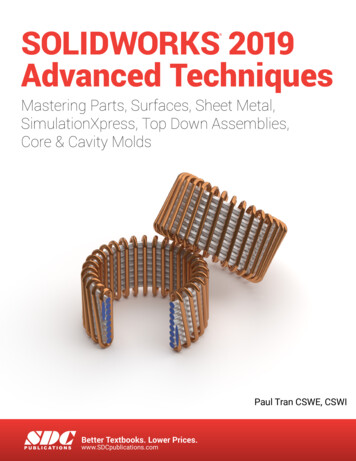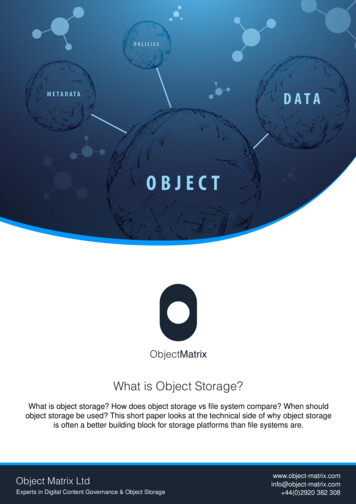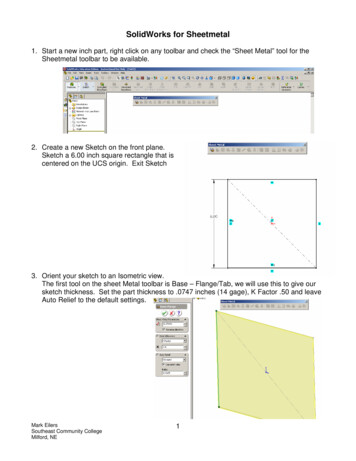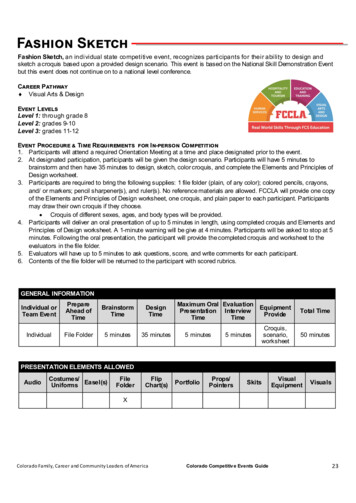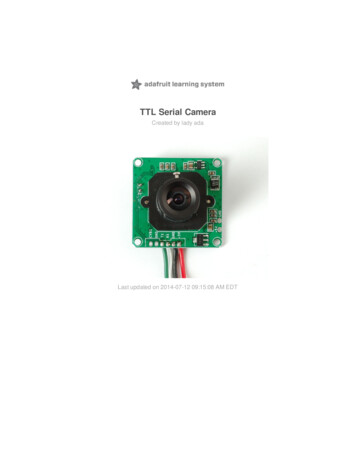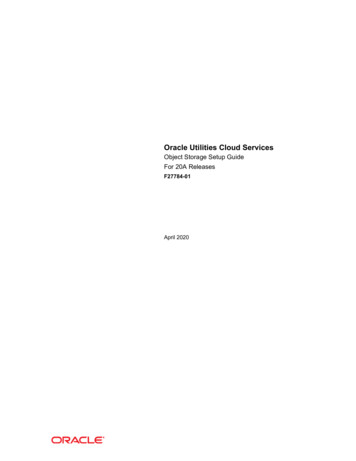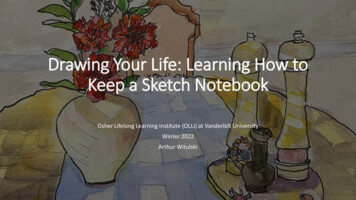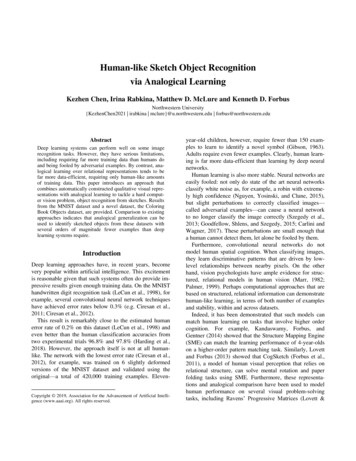
Transcription
Human-like Sketch Object Recognitionvia Analogical LearningKezhen Chen, Irina Rabkina, Matthew D. McLure and Kenneth D. ForbusNorthwestern University{KezhenChen2021 irabkina mclure}@u.northwestern.edu forbus@northwestern.eduAbstractDeep learning systems can perform well on some imagerecognition tasks. However, they have serious limitations,including requiring far more training data than humans doand being fooled by adversarial examples. By contrast, analogical learning over relational representations tends to befar more data-efficient, requiring only human-like amountsof training data. This paper introduces an approach thatcombines automatically constructed qualitative visual representations with analogical learning to tackle a hard computer vision problem, object recognition from sketches. Resultsfrom the MNIST dataset and a novel dataset, the ColoringBook Objects dataset, are provided. Comparison to existingapproaches indicates that analogical generalization can beused to identify sketched objects from these datasets withseveral orders of magnitude fewer examples than deeplearning systems require.IntroductionDeep learning approaches have, in recent years, becomevery popular within artificial intelligence. This excitementis reasonable given that such systems often do provide impressive results given enough training data. On the MNISThandwritten digit recognition task (LeCun et al., 1998), forexample, several convolutional neural network techniqueshave achieved error rates below 0.3% (e.g. Ciresan et al.,2011; Ciresan et al., 2012).This result is remarkably close to the estimated humanerror rate of 0.2% on this dataset (LeCun et al., 1998) andeven better than the human classification accuracies fromtwo experimental trials 96.8% and 97.8% (Harding et al.,2018). However, the approach itself is not at all humanlike. The network with the lowest error rate (Ciresan et al.,2012), for example, was trained on 6 slightly deformedversions of the MNIST dataset and validated using theoriginal—a total of 420,000 training examples. ElevenCopyright 2019, Association for the Advancement of Artificial Intelligence (www.aaai.org). All rights reserved.year-old children, however, require fewer than 150 examples to learn to identify a novel symbol (Gibson, 1963).Adults require even fewer examples. Clearly, human learning is far more data-efficient than learning by deep neuralnetworks.Human learning is also more stable. Neural networks areeasily fooled: not only do state of the art neural networksclassify white noise as, for example, a robin with extremely high confidence (Nguyen, Yosinski, and Clune, 2015),but slight perturbations to correctly classified images—called adversarial examples—can cause a neural networkto no longer classify the image correctly (Szegedy et al.,2013; Goodfellow, Shlens, and Szegedy, 2015; Carlini andWagner, 2017). These perturbations are small enough thata human cannot detect them, let alone be fooled by them.Furthermore, convolutional neural networks do notmodel human spatial cognition. When classifying images,they learn discriminative patterns that are driven by lowlevel relationships between nearby pixels. On the otherhand, vision psychologists have ample evidence for structured, relational models in human vision (Marr, 1982;Palmer, 1999). Perhaps computational approaches that arebased on structured, relational information can demonstratehuman-like learning, in terms of both number of examplesand stability, within and across datasets.Indeed, it has been demonstrated that such models canmatch human learning on tasks that involve higher ordercognition. For example, Kandaswamy, Forbus, andGentner (2014) showed that the Structure Mapping Engine(SME) can match the learning performance of 4-year-oldson a higher-order pattern matching task. Similarly, Lovettand Forbus (2013) showed that CogSketch (Forbus et al.,2011), a model of human visual perception that relies onrelational structure, can solve mental rotation and paperfolding tasks using SME. Furthermore, these representations and analogical comparison have been used to modelhuman performance on several visual problem-solvingtasks, including Ravens’ Progressive Matrices (Lovett &
Forbus 2018), performing at the 75th percentile, which isbetter than most adult Americans.This paper demonstrates that the combination of the human-like visual system of CogSketch and analogical generalization can also perform sketched object recognition.Sketch data has high variability and is relatively hard tocollect in large quantities (Eitz, Hayes and Alexa, 2012),which is likely to pose problems for deep learning models.However, we show that our approach has reasonablerecognition results on two different types of sketches despite having only sparse data with high variability.We begin by describing our approach, including dataencoding and analogical learning. We then present resultsfor experiments on object recognition in sketches usingtwo datasets: the MNIST handwritten digit dataset (LeCunet al., 1998) and a novel dataset, the Coloring Book Objects dataset, which consists of drawings of everyday objects and animals. Finally, we look at related work anddiscuss future directions for this line of research.ApproachSketch understanding can start with digital ink or bitmaps.Here we start with bitmaps, to provide a closer comparisonwith vision-based approaches. Consequently, the first stepis converting bitmaps into digital ink, and then using CogSketch to construct relational spatial representations. Thesecond step is analogical learning using the relational representations as cases. Figure 1a shows a sketch of a fishfrom the coloring book dataset, used as an example.Bitmap to Structured RepresentationThe process of converting a bitmap input into a structuredvisual representation has three stages: (1) bitmap preprocessing to reduce noise, (2) object segmentation to extractthe edges and junctions that make up the sketch, and (3)spatial encoding to create relational representations. Allstages and CogSketch are introduced below.Bitmap PreprocessingGiven a sketched object bitmap, we first convert thesketches to ink vectors for further processing. To reducenoise and speed up the encoding algorithm, each originalimage is resized such that the resized length is below 300pixels. Then, the image is blurred and filtered to black andwhite using a threshold of 70. Potrace, a software tool fortracing bitmaps and Zhang-Suen’s thinning algorithm(1984), are used to generate SVG for input into CogSketch.CogSketch Visual ProcessingCogSketch (Forbus et al., 2011) is an open-domain sketchunderstanding system that automatically constructs relational representations based on visual and conceptual information. CogSketch is capable of computing spatialproperties (attributes and relations) at multiple representational levels on digital-ink sketches. Its basic level representations concern glyphs, which are visual objects.Glyphs are decomposed into edges and junctions, the mostbasic units used by CogSketch. To identify edges, ink isseparated into segments at its discontinuities and junctions.At the edge level, the length, curvature, orientation, position, and topological relations (i.e., type of junctions, suchas T-junction) are computed by CogSketch. Edges can beassembled into edge-cycles that form closed shapes, whichprovide larger units out of which representations of surfaces can be constructed. Edge-cycles have similar propertiesto edges and many properties of polygons, but, unlike polygons, can also have curved edges. Shared edges betweenedge-cycles also provide important clues to visual structure. These representations are motivated by psychologicalstudies of human visual processing and spatial cognition,when available, but due to the current state of knowledgein cognitive science, this is somewhat under constrained.Object SegmentationEach digital-ink sketch imported into CogSketch is decomposed into closed edge-cycles and edges. The edgecycles and edges are sorted and stored in a decompositiontree. From outside to inside of the object, each edge orclosed edge-cycle is stored in a node of the decompositiontree from root to leaves, so the root node contains the contour edge-cycle of the whole sketched object. Figure 1bshows the edge-cycle decomposition of the sketched fishdepicted in Figure 1a. Figure 1c shows the correspondingFigure 1: (a) is a sketched fish from Coloring book dataset. (b) is the edge-cycle decomposition of (a) from CogSketch. (c) is the corresponding decomposition tree. (d) is the medial-axis transform of the contour edge-cycle of (a). (e) is the segmentation result.
decomposition tree. Note that the inner edge-cycles correspond to the eye, fins, body, and head of the fish.To represent properties of edge-cycles, we draw onBiederman’s (1987) recognition-by-components theory,that people seem to encode visual input as a combinationof simple shapes. Thus, each edge-cycle is segmented anddescribed by several attributes. For example, the medialaxis transform is found by computing the grassfire transform (Blum, 1967). For each medial axis point, a pair ofclosest points on the edge-cycle is generated. The pairs arethen iterated over, to find closures of the edge-cycle. Aclosure contains at least one concave point relative to theedge-cycle. A line segment is added for each closure.To reduce segmentation noise, we add several constraints on closure detection. These are: (1) the sum of theangles of two closure points should be less than 3.05 radians, (2) one of the angles of two closure points should beless than 2.85 radians, (3) the distance between the twopoints of each closure should be less than one sixth thelength of the perimeter of the edge cycle, (4) only one closure with smallest angle sum is detected in a certain range(i.e. 1/20th the length of contour) and (5) all segmentswhose area is below a preset threshold and which do notconnect more than one other segments are dropped. Theseparameters were all determined experimentally on pilotdata. Figure 1d shows the medial-axis transform of theFigure 1a contour. Figure 1e shows the edge-cycle segmentation of the Figure 1a contour. Notice that each edgecycle in the decomposition tree (Figure 1c) is segmentedinto several pieces for later encoding. There are five closures detected in Figure 1e.Spatial EncodingAfter decomposition and segmentation are completed, thespatial relations between edge-cycles and segments areencoded. Each edge-cycle is described as a combination ofthe attributes of its segments, as well as the positional relations and connection relations between segments.Attribute selection for segments and edge-cycles poses atricky trade-off: the more attributes described, the moredetails of the segment are available—and the more trainingexamples are needed to learn useful generalizations in analogical learning (see below). To address this trade-off, weuse greedy search to select five attributes with the best discrimination out of eight possible attributes. The selectionof the eight-attribute scheme is based on visual analysis ofthe datasets and inspired by Geons (Biederman, 1987). Allattributes are converted to a qualitative size description(i.e., small, medium and large) according to preset thresholds. Table 1 describes the details of the eight attributes.During encoding, the isa predicate in Cyc is used to express attributes, for example,(isa EdgeCycle-Seg-149 HighSolidity)The connection relations between segments are described via the segmentsConnectToViaEdge predicate.The first argument of this predicate is the connecting edgeof first edge-cycle and the second argument is the secondedge-cycle. For eFn EdgeCycle-Seg-149)EdgeCycle-Seg-152)The positional relations above and leftOf are used todescribe the relations between edge-cycles of the samedegree in the decomposition tree. RCC8 relations (Randellet al., 1992) are used to describe the containing relationsbetween the segments of edge-cycles and their children.The set of entities, attributes, and relations computed fora sketched object are combined to form a case, for use inanalogical learning and classification, as described next.AttributeDescriptionEccentricityThe principal axis ratio computed from the covariance matrix of all polygon contour points.CompactnessThe ratio between the polygon area and estimatedcycle area based on perimeter of polygon.CircularityThe ratio between the standard deviation and meanof radial-distance between polygon contour pointsand polygon centroid.EllipsityThe ratio between the standard deviation and meanof d-primes between polygon contour points andpolygon centroid.ConvexityThe ratio between the perimeter of polygon and theperimeter of its convex hull.SolidityThe ratio between the area of polygon and the areaof its convex hull.OrientationThe orientation of the polygon main axis: vertical,horizontal, and angular.Area SizeThe relative area size of the polygon with respect toother polygons in one segmentation.Table 1: Descriptions of the eight encoding attributesAnalogical LearningHuman learning is broad and general, while being dataefficient. An important advantage of our approach is thatwe are using off-the-shelf analogical learning models,without modification, for this task. The analogical processing models introduced below have considerable psychological evidence supporting them and have been usedfor building AI performance systems for a variety of tasks(Forbus & Hinrichs, 2017).
Structure Mapping Engine (SME)The Structure Mapping Engine (Forbus et al., 2017) is acomputational model of analogical matching and similaritybased on Structure Mapping Theory (Gentner, 1983). Given two cases of structured, relational representations,called a base and a target, SME computes one (or up tothree) mappings between them. A mapping includes a setof correspondences that align entities and relations in thebase and target, a similarity score that indicates how similar the base and the target are, and candidate inferences,which are projections of unaligned structure from one caseto the other, based on the correspondences. Here SME isused both as a similarity metric and as a means of combining cases into generalizations, as described below.MAC/FACThe MAC/FAC algorithm (Forbus, Gentner, and Law,1995) is a model of analogical retrieval. Given a probecase and a case library, it retrieves up to three examplesfrom the case library that are the closest match (i.e., havethe highest similarity score) to the probe. Cases in the caselibrary are structured, relational representations. When acase is stored, a content vector representation is automatically computed for it and stored as well. Each dimensionin a content vector represents a predicate, and its strengthcorresponds to the number of occurrences of it in thatcase1. The dot product of two content vectors provides arough estimate of what SME would compute for a similarity score for the corresponding structured representations,which is used as a pre-filter. The MAC stage is amap/reduce operation, where dot products for a contentvector of the probe is computed in parallel with the vectorsfor all items in the case library, with the top three scoringcases passed on to the FAC stage as output. The FACstage also is map/reduce but using SME on the probe andthe retrieved cases, keeping the best (or up to all three, ifthey are very close to the top). The MAC stage providesscalability, since vector dot products are quite cheap. TheFAC stage provides the sensitivity to structure that humanretrieval demonstrates, probably because structural similarity leads to useful conclusions. Each case returned fromFAC is called a reminding. We use MAC/FAC for retrievalduring both training and testing, as described below. Onlythe top reminding is used.SAGEThe Sequential Analogical Generalization Engine (SAGE;McLure et al., 2015a) is a model of analogical generalization. Each concept to be learned by analogy is representedby a generalization pool, which potentially holds both generalizations and outlying examples. The generalizationsand examples in a concept’s generalization pool represent1In a large knowledge base like OpenCyc, this leads to very sparse vectors, since there are on order of 10-100 non-zero dimensions out of roughly 105.alternative models of the concept. There are two basicoperations: adding an example and classifying an example.Here we assume that each training example is labeledand added to a single SAGE generalization pool. The example is merged to the most similar case retrieved from thepool via MAC/FAC. If nothing is retrieved, or the similarity score associated with the top retrieval is below the assimilation threshold, the training example is added to thegeneralization pool as a new outlier. If the reminding isanother example, then a new generalization is formed.This is done by replacing non-identical aligned entitieswith skolems, a new unique symbol, and taking the unionof the statements involved. A probability is calculated foreach statement—1.0 if it is aligned in the match, and 0.5otherwise. A statement’s probability reflects the frequencywith which the examples assimilated into the generalization contained an expression that mapped to that statement.If the reminding is a generalization, then that generalization is updated, by adding new statements, perhaps newskolems, and updating the probabilities for each statement(statements whose probability gets too low are eventuallydeleted, based on another threshold.). Thus, over time ageneralization pool can have a set of generalizations andoutliers. Each generalization can be thought of as a component of a disjunctive model for the concept. In this senseSAGE is like k-means with outliers, except that there is noa priori determination of the number of clusters; the algorithm derives that from the data.Classification is performed using MAC/FAC, where theprobe is the new example to be classified and the case library is the union of generalization pools representing thepossible classifications. The generalization pool fromwhich the best reminding comes is used as the label forthat example.ExperimentsWe test our approach on two very different sketch datasets,using a relatively small number of training examples.Experiment 1: MNISTThe MNIST handwritten digit dataset (LeCun et al. 1998)is constructed from NIST’s Special Database 3 and SpecialDatabase 1. It consists of 60,000 training images and10,000 testing images of handwritten digits. Each image isa 20x20 pixel bitmap centered on a 28x28 pixel field. Weuse randomly-selected subsets of 10, 100, and 500 imagesfor training and the full test set.MethodAll examples were converted into relational representationsusing the CogSketch pipeline described above. A SAGEassimilation threshold of 0.9 was used in all experiments.For each training set size, three random subsets were se-
lected, and the system was trained on each subset and tested on the full test set.ResultsSee Figure 2 for the average accuracy per digit and Table 2for overall accuracy and standard deviation information foreach training set size compared with the LeNet-5 (LeCunet al., 1998). While the LeNet-5 also performed well usingless than the full MNIST training dataset, note that itlearned over 20 iterations. Our approach saw each exampleonce.But as Figure 3 illustrates, they provide significant variability nonetheless.Figure 3: A subset of examples in CBOFigure 2: Average accuracy per digitMethodsOur ApproachOur ApproachOur ApproachLeNet-5LeNet-5Training Size(per digit)101005001500 x 20 iter6000 x 20 iterOverall Accuracy54.9%76.24%85.03%98.3%99.2%Table 2: Accuracy and standard deviation per training sizeExperiment 2: Sketched Object RecognitionDatasetWe created the Coloring Book Objects dataset2 (hereafterCBO) by collecting images from a collection of openlicense coloring books. It contains 10 bitmap examples foreach of 19 different categories of animals and everydayobjects. Each image is a roughly 900x550 pixel field. Theimages in each category have very high variety includingstyle (e.g. realistic vs. cartoon) and view (e.g. profile vs.frontal). Figure 4 shows some examples from the CBOdataset. We chose objects and animals depicted in coloringbooks because they are designed to be recognizable bychildren, who have had little experience with the world.2The Coloring Book Objects dataset and CogSketch sketches can befound at x.html .MethodWe use leave-one-out cross-validation to perform sketchedobject recognition. In each round, nine images are used astraining data and one image is used for testing. As someanimals or objects have texture or noise, only closed edgecycles as perimeters are encoded into representations. Eachanimal or everyday object category has a generalizationpool. A SAGE assimilation threshold of 0.9 assimilation isused and average accuracy is computed.As a baseline, we compare to results of the CNN modelLeNet-5 (LeCun et al., 1998) trained using the same leaveone-out cross-validation technique. The model has 2 convolution layers with a ReLU activation followed by maxpooling layers and a fully connected layer with softmax.This CNN model performed above 99% accuracy on thefull MNIST training set.Figure 4: The accuracy (%) for each category
ResultsFigure 4 shows the sketched object recognition accuracyfor each category using our approach. Table 3 shows theoverall accuracy and standard deviation of each model.Our approach achieves 29.47% accuracy, which is significantly above chance. The CNN model only achieves 5.26%accuracy, which does not differ from chance.MethodsOur approachLeNet-5Overall able 3: Overall Accuracy and standard deviation resultsDiscussionThese results indicate that CogSketch plus analogical generalization can surpass 85% accuracy on the MNIST dataset using only 500 examples per concept, and reaches76.24% with just 100 examples per concept. We note thatwith LeNet-5 we were not able to get better than chanceperformance until the system was given 1,000 examplesper concept on standard MNIST inputs. We did not getvery competitive results with the state-of-art because theMNIST dataset is a highly down-sampled, to fit the constraints of CNNs at the time, which introduces significantamounts of noise. Even though the preprocessing stageremoves some noise, the object segmentation stage and theattributes CogSketch computations for segment edgecycles still have bias or errors. Thus, some images havesimilar segmentations to other digits. For example, Figure5 shows the confusion matrix from when our system wastrained on 100 examples per digit. A frequent failure modeis the digit two being mistaken for a five, and vice versa.Figure 5: Confusion matrix of MNIST (100 training samples)Figure 6: Confusion matrix of CBO classification resultsThis is an example of the segmentation problem—bothtwos and fives are sometimes interpreted as two segments(essentially a top curve and a bottom curve), connected inthe middle.As mentioned above, attribute selection is a tricky question that needs further exploration. When segments aresimilar, the selected attributes may lose information. Forexample, Figure 5 shows that some nines are recognized asfours. This is because the computed attributes of the edgecycles in these images sometimes cannot distinguish between the upper triangle of a four and the upper circle of anine—both are closed edge cycles. Our results might bebetter with the original NIST dataset, but we have not yetexplored this option.With the Coloring Book Objects dataset, which has extremely high variability, even with only 9 training examples as training data, our system has significantly betteraccuracy than chance, whereas a CNN model performs atonly chance (Table 3). The variability in this dataset isextreme: Animals sometimes have hats, for example. Figure 6 shows the confusion matrix for this dataset. It showsthat our system has high accuracy on simple objects suchas mittens and pencils but cannot distinguish butterfliesand ice-cream—likely because they have complicated texture or shapes. Being able to recursively decompose recognition might be necessary to get very high accuracy on thisdataset.While our results do not yet approach the state of the arton the MNIST dataset and the performance on the Coloring Book Object dataset has plenty of room for improvement, these results already support the hypothesis thatstructured relational representations and off-the-shelf analogical learning models can be used to produce systemsthat learn to recognize object from sketches in more hu-
man-like ways, with far better data efficiency than deeplearning models.Related WorkHere we discuss four existing approaches on learningsketched objects. We highlight where these approachesoverlap with ours, and how they differ.Eitz, Hays and Alexa (2012) created a large dataset ofhuman object sketches containing 80 sketch bitmaps percategory from 250 different categories, called the Berlindataset. They represented sketches using local feature vectors that encode distributions of image properties. Specifically, the distribution of line orientation within a smalllocal region of a sketch is encoded. With the local featurevectors, they partitioned the vectors into k disjunct clustersvia k-means clustering. A frequency histogram of the kclusters is generated as the feature representation ofsketches. With the frequency histograms, KNN and SVMwere tested on the whole dataset. KNN could achievearound 25% accuracy with 10 training examples and 43%accuracy with 80 training examples. SVM could reach31% accuracy with 10 training examples and 55% accuracy with 80 training examples. Prior work with analogicalgeneralization on this dataset (McLure et al., 2015b)achieved similar levels of performance on a subset of thatdatabase by introducing an Ising model to handle texturesover edge-cycles. The integration of Biederman’s recognition-by-components model with CogSketch encoding, introduced here, could be combined with texture encoding toimprove performance on this dataset as well.Seddati, Dupont, and Mahmoudi (2015) presented adeep convolution neural networks (ConvNets) model forsketch recognition, which they tested on the Berlin dataset.The model contains 15 layers, which are a combination ofconvolution layers with ReLU followed by Maxpool layers. Each sketch is rescaled from 1x1111x1111 to1x180x180 and the black and white pixels are reversed.During each iteration of training, 64 samples from 64 different sketches categories were randomly selected. With0.1 learning rate and a momentum equal to 0.9, the modelcould reach 75.42% average accuracy after 80 epochs(epoch 13056 examples presented to the ConvNet).While this accuracy on that corpus is impressive, it uses farmore data than people require on such tasks.On the other hand, Lake et al. (2015) used Bayesianprogram learning (BPL) to learn to recognize handwrittensymbols and generate new, similar examples after seeingonly one example of each symbol, using their framework.Symbols were represented as probabilistic programs—sequences of movements based on pen strokes. Havingseen a single such example of a symbol, the model wasable to match human learning on a similar symbol match-ing task. It was also able to generate similar images thathumans matched to the original with high fidelity. Unfortunately, it is well-known in handwriting recognition thatstroke data is easier to recognize than bitmap data, so wedo not see it as applicable here.Dai and Zhou (2017) used an approach that combinedlogical abduction and statistical induction (LASIN) to learnencodings for hand-written symbols from several datasets.For each dataset, LASIN learned dictionaries of primitiveconcepts combined with background knowledge, such asstrokes or ink clusters, that were then used for encoding thesymbols. The utility of the learned dictionaries was testedusing support vector machines (SVM) with a linear kernel.MNIST was one of several datasets used for testing. With adictionary of 200 strokes, an SVM reached 97% accuracyon 5-fold cross-validation of a randomly selected subset of1000 MNIST training examples (100 per digit). A dictionary of 20 strokes achieved approximately 91% accuracy onthis task. While our approach differs in terms of its encoding strategy and learning method, Dai and Zhou’s resultsprovide evidence that thousands of training examples arenot necessary for robust learning. Rather, it is important todetermine appropriate representations for the forms beinglearned. We argue that the representations used by humansare a good place to start.Conclusions and Future WorkWe have shown that analogical learning over relationalrepresentations is a viable and promising path for sketchrecognition. Our approach is based on a human-like encoding scheme and achieves solid results with a very smallnumber of training examples on different types of sketches.We note that deep learning systems require from 60,000examples (Ciresan et al. 2011) to 420,000 examples (Ciresan et al. 2012) over hundreds of epochs to achieve theperformance that they report on MNIST. Moreover, theColoring Book Objects dataset illustrates that deep learning models have poor performance with small numbers oftraining examples, whereas analogical generalization, despite the high variability of the examples, performs muchbetter.While the data efficiency of analogical generalization isalready very encouraging, we plan several lines of futurework to improve it further. First, we plan to explore dynamic attribute selection, using statistics gleaned fromSAGE to control the choice of attributes in subsequentencoding. Second, we plan to integrate texture representations, as per McLure et al (2015b). Finally, we plan onusing near-miss learning
studies of human visual processing and spatial cognition, when available, but due to the current state of knowledge in cognitive science, this is somewhat under constrained. Each digital-ink sketch imported into CogSketch is de-composed into closed edge-cycles and edges. The edge-cycles and edges are sorted and stored in a decomposition
